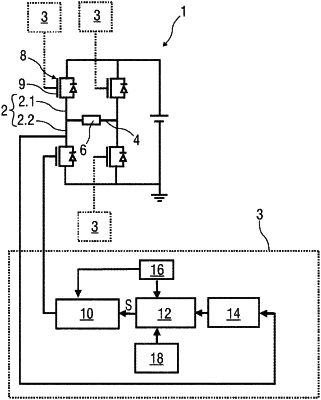| CPC H03K 17/687 (2013.01) [H03K 17/04123 (2013.01); H03K 17/04206 (2013.01); H03K 17/163 (2013.01); H03K 17/166 (2013.01); H03K 17/567 (2013.01)] | 18 Claims |

|
1. A method of switching an electronic component on or off under the control of a pulse-width-modulation signal, the electronic component being configured to output an output signal controlled by way of a control signal, the method comprising:
initiating the switching on or off within a pulse-width-modulation clock period at a level-change instant by a change in the pulse-width-modulation signal at which the pulse-width-modulation signal changes from a lower level to an upper level;
calculating at least one amplitude magnitude of an oscillation of the output signal during each clock period of the pulse-width-modulation signal;
predefining at least one first control value and one second control value of the control signal;
in order to perform the switching on when the switching on has been initiated or in order to perform the switching off when the switching off has been initiated, adjusting the control signal to the first control value within each pulse-width-modulation clock period between the level-change instant and a first switchover instant and adjusting the control signal to the second control value between the first switchover instant and a second switchover instant and adjusting the control signal to a third control value from the second switchover instant until a gate voltage end value of a gate voltage is reached at a control connection of the electronic component, wherein the gate voltage end value is selected to turn on the electronic component when the switching on has been initiated or the gate voltage end value is selected to turn off the electronic component when the switching off has been initiated; and
determining each of the first and second switchover instants of a pulse-width-modulation clock period on a basis of an amplitude magnitude associated with the pulse-width-modulation clock period and calculated during a preceding pulse-width-modulation clock period, to thereby limit oscillation amplitudes of an oscillation of the output signal.
|